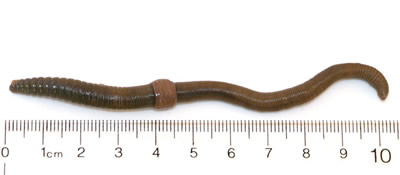Worms in the Woods
Title
Body
Earthworms! The mere word evokes, at least for gardeners, a vision of rich, crumbly, beautifully fertile soils and the luscious vegetables that pour abundantly from them. But for many forest ecologists in the northern parts of the United States, the word strikes them with fear, even terror. The reason? Earthworms are not naturally found in the soils of forests of regions that were covered by glacial ice during the last great Ice Age (termed the Wisconsin glaciations by geologists, which reached its maximum extent about 18,000 years ago.)
Forests in the glaciated regions thus lacked earthworms; in New Jersey, this includes the areas north of an uneven line extending from Woodbridge in Middlesex County, through Morristown, and west to the Delaware River near Phillipsburg, and it includes all of New York north of New York City. But over the past couple of decades, European and Asian species of earthworms have become abundant in forests throughout the glaciated region, with profound and often damaging consequences for the soils, plants and animals of the forests.
Earthworms appear to be very simple and innocuous beasts-a long segmented tube, no appendages, not much difference between the head and tail-that just wriggle and squirm if you pick them up. Most people are only even aware of worms after a hard rain, when they come to the surface of the ground and are found, dying, on sidewalks and roads. But they have fascinating and complex life cycles and behaviors within the soil. These behaviors have very large effects on the structure and chemistry of the soil (whence their importance to gardeners and farmers). Because of the dependence of many forests organisms on the soil, the introduction of earthworms starts a cascade of effects on many other organisms.
In deciduous forests, dead leaves falling to the forest floor in the autumn decay rather slowly, so that a layer of slightly, to partially, to mostly-decayed leaf material builds up on the surface of the soil. This layer of organic material, aptly termed by soil scientists the ‘O' horizon, plays a crucial role in the forest: its loose, spongy structure stores moisture, supplies nutrients for plants, provides an ideal environment for seeds to germinate, and supports an amazing number and diversity of other soil organisms. These in turn provide food for other invertebrates like ants and beetles, and for vertebrates like salamanders, mice, and birds.
Certain kinds of earthworms, termed "anecic" species, create burrows that run vertically from the surface of soil downward, deep into the mineral soil. These species feed on freshly deposited leaves at the surface of the O horizon, and then travel downward in their burrows, excreting digested leaf material as they go. The most common non-native earthworm of this type is the common night crawler, Lumbricus terrestris, a very large worm (up to 10 centimeters, or 4 inches long). Night crawlers can remove all the leaf litter deposited on the soil of a typical hardwood forest every year.
Another type of earthworm, termed "epigeic" (or "over-the-soil"), lives only in the litter and on the surface of the mineral soil. A common non-native species of this type is the leaf worm, or beaver tail, Lumbricus rubellus; it also can rapidly remove the leaf litter from the forest floor.
The third type of earthworm is termed "endogeic" (or "within-the-soil"); these worms live only within the mineral soil, and help mix organic-rich surface soils deeper into the soil profile. These worms are typically grey or pinkish, rather than reddish-brown. A common endogeic worm is the angle worm, Aporrectodea caliginosa, often found in gardens. There are at least 15 different species of non-native worms that are now established in northern forests.
Forests in which these worms have become established are devoid of leaf litter. The lack of leaf litter in turn results in the loss of many native forest plants, including ferns, wildflowers, and tree seedlings. Conversely, and perhaps diabolically, the lack of litter promotes the establishment and growth of some of the most invasive non-native plant species, such as Japanese stilt grass (Microstegium vimineum), seen in almost every forest in our region. The loss of the leaf litter is also thought to result in a loss of salamanders, the most abundant vertebrate in the forest.
Earthworm-invaded forests are found throughout our region; they are easily spotted by the lack of leaf litter, and often by the abundant presence of exotic plants. Look on the soil surface for the signature "casts" of the worms-small piles of tiny pellets or crumbs.
Non-native worms have been transported to the United States through all types of commerce and activities that move soil around-horticultural plants, garden plants, dirt on the wheels of vehicles, or even hiking boots, or the bottoms of boats. Worms have also been moved around by the hundreds of millions for fishing bait.
Scientists do not yet have a way of ridding forests of them once they are established. However, we can try to keep them from spreading to forests that are as yet uninvaded, by reducing direct introduction, and by reducing the movement of soil.
• Don't throw away unused fishing bait!
• Don't put compost that contains worms or was made in a worm-compositing system, into your garden if you live near a forest!
• Wash your boots between hikes!
• And if you, or your friends, use mountain bikes on the trails, wash them too!
For more information about earthworm invasions, see the following websites:
Great Lakes Worm Watch
Brooklyn Botanic Garden
